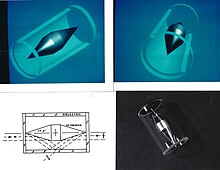Radial polarization

A beam of light has radial polarization if at every position in the beam the polarization (electric field) vector points towards the center of the beam. In practice, an array of waveplates may be used to provide an approximation to a radially polarized beam. In this case the beam is divided into segments (eight, for example), and the average polarization vector of each segment is directed towards the beam centre.[1]

Radial polarization can be produced in a variety of ways. It is possible to use so-called q-devices[2] to convert the polarization of a beam to a radial state. The simplest example of such devices is inhomogeneous anisotropic birefringent waveplate that performs transversally inhomogeneous polarization transformations of a wave with a uniform initial state of polarization. The other examples are liquid crystal,[3] and metasurface q-plates. In addition, a radially polarized beam can be produced by a laser, or any collimated light source, in which the Brewster window is replaced by a cone at Brewster's angle. Called a "Rotated Brewster Angle Polarizer," the latter was first proposed and put into practice (1986) to produce a radially-polarized annular pupil by Guerra [4] at Polaroid Corporation (Polaroid Optical Engineering Dept., Cambridge, Massachusetts) to achieve super-resolution in their Photon Tunneling Microscope. A metal bi-cone, formed by diamond-turning, was mounted inside a glass cylinder. Collimated light entering this device underwent two air-metal reflections at the bi-cone and one air-glass reflection at the Brewster angle inside the glass cylinder, so as to exit as radially-polarized light. A similar device was later proposed again by Kozawa.[5]
A related concept is azimuthal polarization, in which the polarization vector is tangential to the beam. If a laser is focused along the optic axis of a birefringent material, the radial and azimuthal polarizations focus at different planes. A spatial filter can be used to select the polarization of interest.[6] Beams with radial and azimuthal polarization are included in the class of cylindrical vector beams.[7]
A radially polarized beam can be used to produce a smaller focused spot than a more conventional linearly or circularly polarized beam,[8] and has uses in optical trapping.[9]
It has been shown that a radially polarized beam can be used to increase the information capacity of free space optical communication via mode division multiplexing,[10] and radial polarization can "self-heal" when obstructed.[11]
At extreme intensities, radially-polarized laser pulses with relativistic intensities and few-cycle pulse durations have been demonstrated via spectral broadening, polarization mode conversion and appropriate dispersion compensation.[12] The relativistic longitudinal electric field component has been proposed as a driver for particle acceleration in free space[13][14] and demonstrated in proof-of-concept experiments.[15]
References
- ^ Saito, Y.; Kobayashi, M.; Hiraga, D.; Fujita, K.; et al. (March 2008). "z-Polarization sensitive detection in micro-Raman spectroscopy by radially polarized incident light". Journal of Raman Spectroscopy. 39 (11): 1643–1648. Bibcode:2008JRSp...39.1643S. doi:10.1002/jrs.1953.
- ^ Petrov, N. V.; Sokolenko, B.; Kulya, M. S.; Gorodetsky, A.; Chernykh, A. V. (2 August 2022). "Design of broadband terahertz vector and vortex beams: I. Review of materials and components". Light: Advanced Manufacturing. 3 (4): 43. doi:10.37188/lam.2022.043.
- ^ "Radial-Azimuthal Polarization Converter". ARCoptix. Retrieved 30 September 2008.
- ^ Guerra, John (1990). "Photon Tunneling Microscopy". Applied Optics. 29 (26): 3741–3752. Bibcode:1990ApOpt..29.3741G. doi:10.1364/AO.29.003741. PMID 20567479. S2CID 23505916.
- ^ Kozawa, Yuichi; Sato, Shunichi (2005). "Generation of a radially polarized laser beam by use of a conical Brewster prism". Optics Letters. 30 (22): 3063–3065. Bibcode:2005OptL...30.3063K. doi:10.1364/OL.30.003063. PMID 16315722.
- ^ Erdélyi, Miklós; Gajdátsy, Gábor (2008). "Radial and azimuthal polarizer by means of a birefringent plate". Journal of Optics A: Pure and Applied Optics. 10 (5): 055007. Bibcode:2008JOptA..10e5007E. doi:10.1088/1464-4258/10/5/055007.
- ^ Zhan, Qiwen (2009). "Cylindrical vector beams: from mathematical concepts to applications". Advances in Optics and Photonics. 1 (1): 1. doi:10.1364/AOP.1.000001.
- ^ Quabis, S.; Dorn, R.; Muller, J.; Rurimo, G.K.; et al. (2004). Radial polarization minimizes focal spot size. Washington, OSA, Optical Society of America: Optical Society of America. doi:10.1364/IQEC.2004.IWG3. ISBN 978-1-55752-778-3.
{{cite book}}:|journal=ignored (help) - ^ Qiwen Zhan (2004). "Trapping metallic Rayleigh particles with radial polarization". Optics Express. 12 (15): 3377–3382. Bibcode:2004OExpr..12.3377Z. doi:10.1364/OPEX.12.003377. PMID 19483862.
- ^ Giovanni Milione; et al. (2015). "4 × 20 Gbit/s mode division multiplexing over free space using vector modes and a q-plate mode (de)multiplexer". Optics Letters. 40 (9): 1980–1983. arXiv:1412.2717. Bibcode:2015OptL...40.1980M. doi:10.1364/OL.40.001980. PMID 25927763. S2CID 31723951.
- ^ Giovanni Milione; et al. (2015). "Measuring the self-healing of the spatially inhomogeneous states of polarization of vector Bessel beams". Journal of Optics. 17 (3): 035617. Bibcode:2015JOpt...17c5617M. doi:10.1088/2040-8978/17/3/035617. S2CID 53445904.
- ^ Carbajo, Sergio; Granados, Eduardo; Schimpf, Damian; Sell, Alexander; Hong, Kyung-Han; Moses, Jeff; Kärtner, Franz (15 April 2014). "Efficient generation of ultra-intense few-cycle radially polarized laser pulses". Optics Letters. 39 (8): 2487–2490. Bibcode:2014OptL...39.2487C. doi:10.1364/OL.39.002487. PMID 24979025.
- ^ Salamin, Yousef; Hu, S.X.; Hatsagortsyan, Karen Z.; Keitel, Christoph H. (April 2006). "Relativistic high-power laser–matter interactions". Physics Reports. 427 (2–3): 41–155. Bibcode:2006PhR...427...41S. doi:10.1016/j.physrep.2006.01.002.
- ^ Wong, Liang Jie; Hong, Kyung-Han; Carbajo, Sergio; Fallahi, Arya; Piot, Phillippe; Soljačić, Marin; Joannopoulos, John; Kärtner, Franz; Kaminer, Ido (11 September 2017). "Laser-Induced Linear-Field Particle Acceleration in Free Space". Scientific Reports. 7 (1): 11159. Bibcode:2017NatSR...711159W. doi:10.1038/s41598-017-11547-9. PMC 5593863. PMID 28894271.
- ^ Carbajo, Sergio; Nanni, Emilio; Wong, Liang Jie; Moriena, Gustavo; Keathlye, Phillip; Laurent, Guillaume; Miller, R. J. Dwayne; Kärtner, Franz (24 February 2016). "Direct longitudinal laser acceleration of electrons in free space". Physical Review Accelerators and Beams. 19 (2). 021303. arXiv:1501.05101. Bibcode:2016PhRvS..19b1303C. doi:10.1103/PhysRevAccelBeams.19.021303.